Northern lapwing
- Peewits redirects here. Distinguish from PWITS = "possession with intent to supply" (an illegal drug trade-related criminal charge.)
| Northern lapwing | |
|---|---|
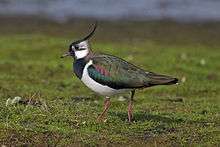 | |
| Scientific classification | |
| Kingdom: | Animalia |
| Phylum: | Chordata |
| Class: | Aves |
| Order: | Charadriiformes |
| Family: | Charadriidae |
| Genus: | Vanellus |
| Species: | V. vanellus |
| Binomial name | |
| Vanellus vanellus (Linnaeus, 1758) | |
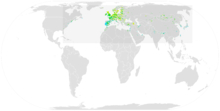 | |
| Global range Year-Round Range Summer Range Winter Range | |
| Synonyms | |
|
Tringa vanellus Linnaeus, 1758 | |
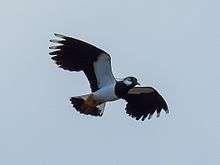
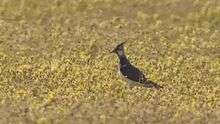
The northern lapwing (Vanellus vanellus), also known as the peewit, pewit, tuit or tew-it (imitative of its cry), green plover (emphasising the colour of the plumage) or (in the British Isles) just lapwing (which refers to its peculiar, erratic way of flying), is a bird in the lapwing family. It is common through temperate Eurasia.
It is highly migratory over most of its extensive range, wintering further south as far as north Africa, northern India, Pakistan, and parts of China. It migrates mainly by day, often in large flocks. Lowland breeders in westernmost areas of Europe are resident. It occasionally is a vagrant to North America, especially after storms, as in the Canadian sightings after storms in December 1927 and in January 1966.[2]
It is a wader which breeds on cultivated land and other short vegetation habitats. 3–4 eggs are laid in a ground scrape. The nest and young are defended noisily and aggressively against all intruders, up to and including horses and cattle.
In winter, it forms huge flocks on open land, particularly arable land and mud-flats.
Etymology
The name lapwing has been variously attributed to the "lapping" sound its wings make in flight, from the irregular progress in flight due to its large wings (OED derives this from an Old English word meaning "to totter"),[3] or from its habit of drawing potential predators away from its nest by trailing a wing as if broken.
The scientific name Vanellus is Medieval Latin for the northern lapwing and derives from vannus a winnowing fan.[4]
Description
The northern lapwing is a 28–33 cm (11–13 in) long bird with a 67–87 cm (26–34 in) wingspan and a body mass of 128–330 g (4.5–11.6 oz).[5] It has rounded wings and a crest. It is also the shortest-legged of the lapwings. It is mainly black and white, but the back is tinted green. The male has a long crest and a black crown, throat and breast contrasting with an otherwise white face. Females and young birds have shorter crests, and have less strongly marked heads, but plumages are otherwise quite similar.
This is a vocal bird in the breeding season, with constant calling as the crazed tumbling display flight is performed by the male. The typical contact call is a loud, shrill "pee-wit" from which they get their other name of peewit.[3] Displaying males usually make a wheezy "pee-wit, wit wit, eeze wit" during their display flight, these birds also make squeaking or mewing sounds.
It feeds primarily on insects and other small invertebrates. This species often feeds in mixed flocks with golden plovers and black-headed gulls, the latter often robbing the two plovers, but providing a degree of protection against predators.
Like the golden plovers, this species prefers to feed at night when there is moonlight.
The northern lapwing is one of the species to which the Agreement on the Conservation of African-Eurasian Migratory Waterbirds (AEWA) applies.
Population decline
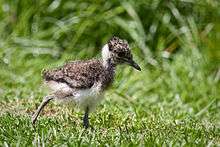

National surveys of England and Wales have shown a population decline between 1987 and 1998 . The numbers of this species have been adversely affected by intensive agricultural techniques. In the lowlands this includes the loss of rough grassland, conversion to arable or improved grassland, loss of mixed farms, and switch from spring to autumn sown crops. In the uplands, the losses may have been due to increases in grazing density.
Natural England gives grant aid to help restore lapwing habitat within its Environmental Stewardship Scheme. The organisation suggests an option within this scheme called 'Fallow plots for ground-nesting birds'. Uncropped plots at least 2 ha (4.9 acres) in size provide nesting habitat and are located in suitable arable fields, which provide additional foraging habitat.
Locating the plots within 2 km (1.2 mi) of extensively grazed grassland will provide additional foraging habitat. The plots are cultivated in the spring to produce a rough fallow, which is retained without the input of fertiliser or pesticides.[6]
Cultural significance
Harvesting eggs
"Plover's eggs" were an expensive delicacy in Victorian Europe, mentioned in Evelyn Waugh's Brideshead Revisited, about aristocratic British society in 1920–40. In the Netherlands, there is a cultural-historical competition to find the first peewit egg of the year (het eerste kievietsei). It is especially popular in the province Friesland, but there are also regional competitions. Gathering peewit eggs is prohibited by the European Union, but Friesland was granted an exception for cultural-historical reasons. The Frisian exception was removed in 2005 by a court, which determined that the Frisian executive councillors had not properly followed procedure.[7][8] As of 2006 it is again allowed to look for peewit eggs between 1 March and 9 April, though harvesting those eggs is now forbidden. The first egg of 2008 was found on 3 March, in Eemnes, Utrecht,[9] as was the first egg of 2009 found on 8 March.[10] Over the last century, the first peewit egg is found earlier and earlier. This is ascribed to both increased use of fertiliser and climate change, causing earlier grass growth needed for egg laying.[11]
Mythology
The bird referred to in English translations of Ovid's Metamorphoses, book 6, as lapwing[12] is probably the northern lapwing. Tereus is turned into an epops (6.674); Ovid presumably had the hoopoe in mind, whose crest indicates his royal status and whose long, sharp beak is a symbol of his violent nature.
References
- ↑ BirdLife International (2015). "Vanellus vanellus". IUCN Red List of Threatened Species. Version 2015. International Union for Conservation of Nature. Retrieved 24 January 2016.
- ↑ Godfrey, W. Earl (1986). The Birds of Canada (Revised ed.). National Museum of Natural Sciences. p. 179. ISBN 0-660-10758-9.
- 1 2 "Lapwing". Oxford English Dictionary (3rd ed.). Oxford University Press. September 2005. (Subscription or UK public library membership required.)
- ↑ Jobling, James A (2010). The Helm Dictionary of Scientific Bird Names. London: Christopher Helm. p. 397. ISBN 978-1-4081-2501-4.
- ↑ "Northern Lapwing Vanellus vanellus". oiseaux-birds].
- ↑ "Lapwings thrive on fallow plots". BTO News (269): 17. March–April 2007.
- ↑ Walinga, Ruurd (17 March 2005). "Dertig jaar juridische strijd om kievitseieren" [Thirty year legal battle for plover's eggs] (in Dutch). Friesch Dagblad. Retrieved 19 February 2009.
- ↑ Stichting De Faunabescherming and Nederlandse Vereniging tot bescherming van Vogels vs. het college van gedeputeerde staten van Fryslân, LJN: AT0660, Rechtbank Leeuwarden , 03/518 BESLU & 03/547 BESLU (Rechtbank Leeuwarden 16 March 2005).
- ↑ "Eerste kievitsei van 2008 gevonden" [First plover egg of 2008 found] (in Dutch). Nederlandse Omroep Stichting. 3 March 2008. Archived from the original on 10 March 2008. Retrieved 19 February 2009.
- ↑ "Dutch spring heralded by lapwing egg". Radio Netherlands / Expatica. 8 March 2009. Retrieved 9 March 2009.
- ↑ "Vinddatum eerste kievitsei in Friesland" [Dates of Discovery of the First Plover's Eggs in Friesland] (in Dutch). Milieu & Natuurcompendium. 6 June 2008. Retrieved 19 February 2009.
- ↑ Garth, Sir Samuel; Dryden, John; et al. "'Metamorphoses' by Ovid".
External links
| Wikimedia Commons has media related to Vanellus vanellus. |
| Wikispecies has information related to: Vanellus vanellus |
| Wikisource has the text of the 1905 New International Encyclopedia article Lapwing. |
- RSPB Birds by Name – Lapwing
- Lapwing photos at ebepe.com
- Ageing and sexing (PDF; 5.7 MB) by Javier Blasco-Zumeta & Gerd-Michael Heinze
- "Northern lapwing media". Internet Bird Collection.
- Lapwing Hatchlings video from Gallery of Living Nature
- Vanellus vanellus in the Flickr: Field Guide Birds of the World
- BirdLife species factsheet for Vanellus vanellus
- "Vanellus vanellus". Avibase.

- Northern lapwing photo gallery at VIREO (Drexel University)
- Audio recordings of Northern lapwing on Xeno-canto.
